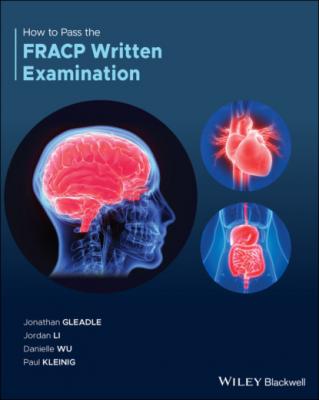How to Pass the FRACP Written Examination. Jonathan Gleadle
Читать онлайн.| Название | How to Pass the FRACP Written Examination |
|---|---|
| Автор произведения | Jonathan Gleadle |
| Жанр | Медицина |
| Серия | |
| Издательство | Медицина |
| Год выпуска | 0 |
| isbn | 9781119599548 |
Levosimendan enhances the calcium sensitivity of troponin C, resulting in increased cardiac output, and also causes peripheral vasodilation, through activation of ATP‐sensitive potassium channels in peripheral vessels. Omecamtiv is a newer inotrope that acts as a selective cardiac myosin activator, which is currently being studied in relation to therapy for left ventricular dysfunction.
Arrigo M, Mebazaa A. Understanding the differences among inotropes. Intensive Care Medicine. 2015;41(5):912–915.
https://link.springer.com/article/10.1007/s00134‐015‐3659‐7
32. Answer: H
This patient has clinical features of life‐threating asthma. Please see the following criteria.
Near fatal asthma
Raised PaCO2 and/or requiring mechanical ventilation with raised inflation pressures.
Life‐threatening asthma
Any one of the following in a patient with severe asthma:
Peak expiratory flow (PEF) <33% best or predicted
SpO2<92%
PaO2<60mmHg
Normal PaCO2
Silent chest
Cyanosis
Feeble respiratory effort
Bradycardia
Dysrhythmia
Hypotension
Exhaustion
Confusion
Coma
Acute severe asthma
Any one of:
PEF 33–50% best or predicted
Respiratory rate >25/min
Heart rate >110/min
Inability to complete sentences in one breath.
Initial management for life‐threatening asthma includes:
Take an ABG.
Give high concentrations of inspired oxygen aiming to achieve oxygen saturations >92%.
Give short‐acting β2‐agonists, salbutamol repeatedly in 5mg doses or by continuous nebulization at 10 mg/h driven by oxygen.
Add nebulized ipratropium bromide to nebulized salbutamol for all patients with life‐threatening asthma as it has been shown to produce significantly greater bronchodilation than β2 agonists alone.
Give high dose intravenous hydrocortisone to all patients with life‐threatening asthma as early as possible in the episode, as this may improve survival.
Give a single intravenous dose of magnesium sulphate 1.2–2g over 20 min if there is no improvement after performing the above. It has been shown to be safe and effective in acute severe asthma. Magnesium is a smooth muscle relaxant, producing bronchodilation. Rapid administration may be associated with hypotension. As this patient’s BP is low, it is better to be given after transfer to ICU.
Transfer to ICU for consideration of intravenous bronchodilators, epinephrine and mechanical ventilation.
Australian Asthma Handbook [Internet]. Asthmahandbook.org.au. 2020 [cited 7 July 2020]. Available from:
http://www.asthmahandbook.org.au/acute-asthma/clinical
33. Answer: C
This patient has collapse and VT due to hyperkalaemia after missing his regular haemodialysis. The best immediate treatment is intravenous administration of 10 ml 10% calcium chloride to stabilise the myocardial cell membrane and lower the risk of VF. Calcium chloride is preferred over calcium gluconate for a patient experiencing a cardiac arrest because the chloride formulation has approximately 3 times the amount of elemental calcium compared with the gluconate formulation. Furthermore, gluconate must be hepatically metabolized before its associated calcium becomes bioavailable, which is unlikely in the setting of hemodynamic instability or poor liver function during cardiac arrest. Calcium chloride is preferably given intravenously via a central or a large peripheral line to avoid any potentially harmful effects should extravasation occur.
Hyperkalaemia raises the resting membrane potential, causing a narrowing between resting membrane potential and threshold potential for action potential generation. Calcium restores this initial narrowing back towards 15 mV by raising the threshold potential to being ‘less negative’. Calcium results in improvement in ECG changes within minutes of administration.
Calcium is essential for normal muscle and nerve activity. It transiently increases peripheral resistance, myocardial excitability and contractility. Randomized control trials and observational studies have demonstrated no survival benefits when calcium was given in‐hospital or out‐of‐hospital cardiac arrest patients. In VF, calcium did not restore spontaneous circulation.
Ahee P. The management of hyperkalaemia in the emergency department. Emergency Medicine Journal. 2000;17(3):188–191.https://emj.bmj.com/content/17/3/188
34. Answer: J
This patient’s cardiac monitor demonstrates torsade de pointes. It is the result of QTc prolongation which can either be congenital or acquired. Acquired QTc prolongation is most often drug‐related. There are many medications that can predispose a person to torsades such as antiarrhythmics, antipsychotics, antiemetics, antifungals, and antimicrobials. Prolonged QTc and Torsades are also associated with hypokalaemia, hypocalcaemia, hypomagnesemia, bradycardia, and heart failure.
Magnesium is an electrolyte essential for membrane stability. Hypomagnesaemia causes myocardial hyperexcitability particularly in the presence of hypokalaemia and digoxin. Electrical cardioversion should be performed for patients with hypotension or in cardiac arrest from torsades de pointes. Intravenous magnesium is the first‐line pharmacologic therapy of torsades de pointes. The recommended initial dose of magnesium is a slow 2 g IV push. An infusion of 1g to 4 g/hr should be started to keep the magnesium
